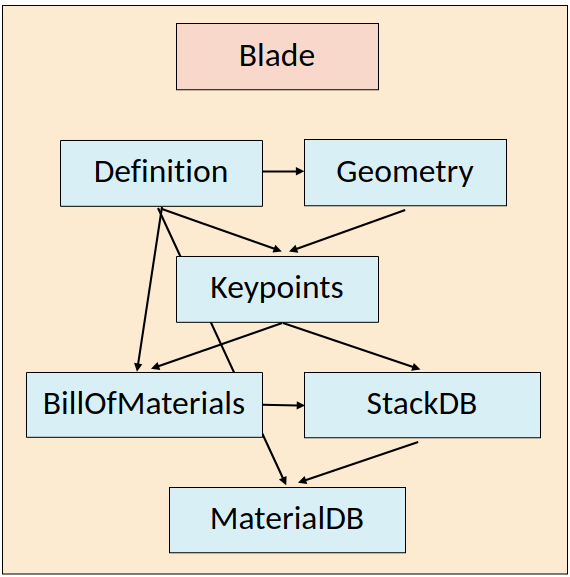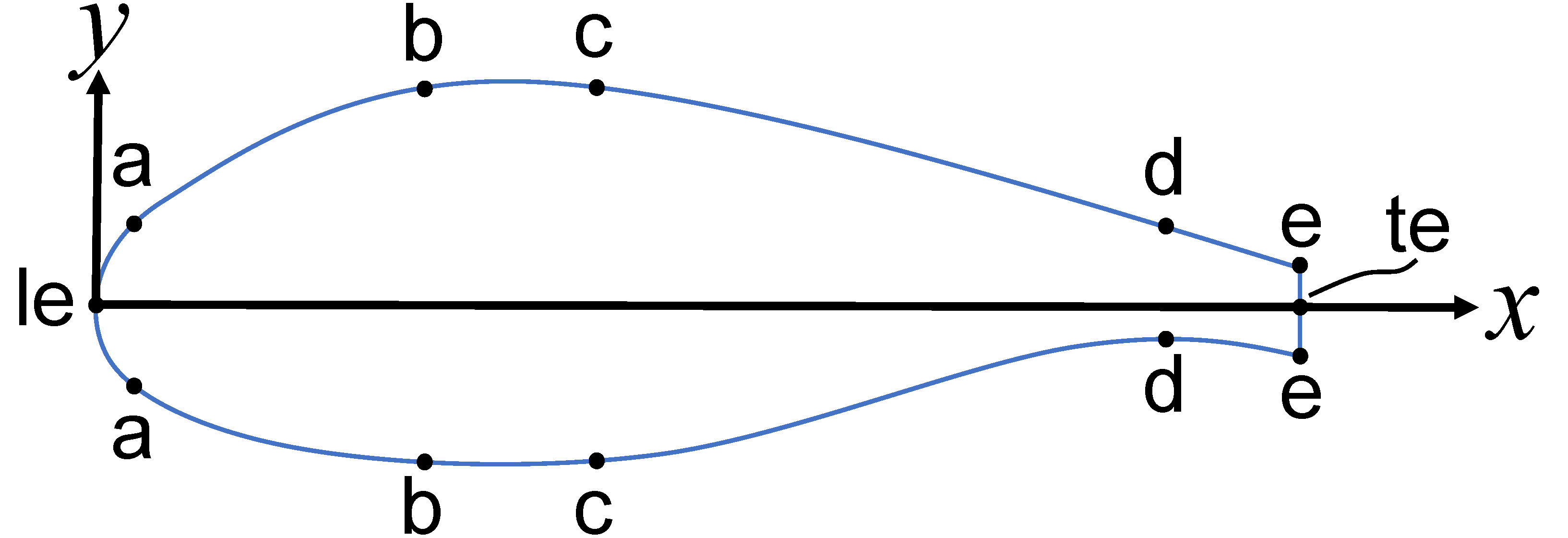Blade Overview#
The fundamental class of pyNuMAD is the Blade class. Each blade object houses a collection of subobjects as attributes which organize the various parameters and data of the blade in a logical fashion. In what follows, each of these primary attributes of the blade are explained at a high-level. For more information, please refer to the API documentation. The below figure illustrates the dependencies between various blade subobjects. For example, a definition object is required to generate geometry, keypoints, bill of material, and material database.

Fig. 1 Dependency tree for blade subobjects#
Definition (blade.definition)#
A Definition
object provides attributes for the basic design
of a wind turbine blade - i.e. where the blade is defined.
Typically this is populated by
a yaml file or an excel file, however it is possible to build a blade
from scratch by manually assigning all of the necessary attributes.
Once a definition object has been loaded in either manually or from
a file, a user can make additional modifications to the blade, such as
adding additional station locations or changing material assignments, before
generating downstream data.
Many of the attributes in Definition are parameterized by spanwise location.
For example, stations are airfoils at specified span locations.
Other airfoil properties and external blade shape data are
defined with the Airfoil
class and the Station object respectively, and are stored in definition.stations.
Material properties, layup information, and thicknesses and widths are
defined in the Material and Component classes
and stored in blade.materials and blade.components.
Geometry (blade.geometry)#
Typically, the blade definition does not contain
high enough fidelity data for creating a mesh, so
pyNuMAD performs additional interpolation to
create a more detailed geometry. The Geometry class generates
and stores the interpoloated geometry. Many of the attributes are named as iattribute
where attribute is the name of some attribute in the definition which was interpolated. Additionally
the coordinates attribute holds the 3D geometry of the interpolated blade.
Keypoints (blade.keypoints)#
The Keypoints class generates and organizes data related
to keypoints.
Airfoils are partitioned by keypoints,
as shown in Fig. 2. Various definition properties such as
definition.leband,
definition.teband, definition.sparcapwidth,
and definition.sparcapoffset help to
position the keypoints precisely. For example, definition.leband is the
arclength from the le keypoint to the keypoint a. Regions are
defined between the keypoints as listed in Table 1.
Adjacent stations help to define these regions as areas. Spanwise lines emanating
from each keypoint are connected to the corresponding keypoints on an
adjacent station; thus bounding the region with four curves. A suffix of
either HP or LP is added to each region name to distinguish regions on
the high pressure surface verses the low pressure surface.

Fig. 2 Keypoint locations#
Region Name |
Bounding Keypoints |
|---|---|
LE |
le & a |
LE Panel |
a & b |
Spar |
b & c |
TE Panel |
c & d |
TE REINF |
d & e |
TE Flatback |
e & te |
StackDB (blade.stackdb)#
The StackDatabase class serves to assign material
stack information across the blade. The stacks attribute stores stack information
for the outer blade shape and takes the form of a 2-dimensional array. The first
dimension represents segment (as determined by keypoints)
and the second dimension represents station (index along interpolated
blade span). The swstacks attribute stores stack information for the shearwebs
and also takes the form of a 2D array, where the first dimension is the shearweb
number, and the second dimension is also the station.
BillOfMaterials (blade.bom)#
The BillOfMaterials class organizes material types and quantities in a blade. However, this class is not currently used in pyNuMAD analyses and only exists for legacy reasons.
MaterialDB (blade.materialdb)#
The MaterialDB class is another class for organizing materials. However, this class also is not currently used in pyNuMAD analyses and only exists for legacy reasons.